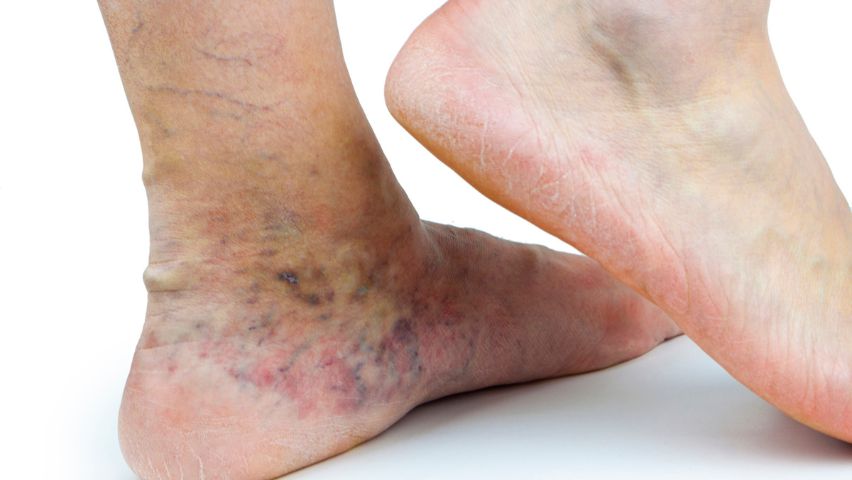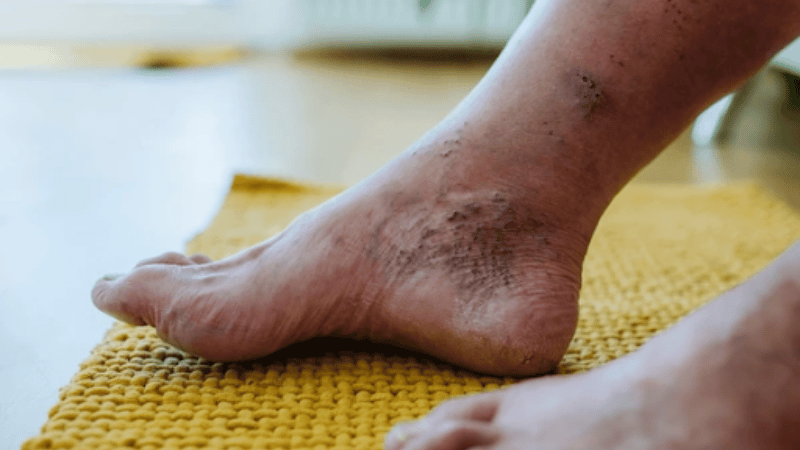Most people have had blue, discolored hands and feet after spending time in colder weather. Cold weather constricts your blood vessels, resulting in blue, purple, or pale hands and feet. This usually isn’t concerning, but it can be if you’re experiencing other symptoms, such as leg pain and wounds that take longer than a few months to heal.
The combination of these symptoms might indicate a condition known as peripheral artery disease (PAD). PAD happens when plaque forms in your arteries, inhibiting blood flow and impacting your mobility. If symptoms are ignored, PAD can get progressively worse and lead to heart attack, stroke, or amputation. Seeing a vascular specialist may help prevent your condition from getting worse.
In this blog, we’ll discuss what you need to know about blue, discolored feet: what causes them, how they relate to PAD, and what you can do to improve your symptoms.
What Causes Blue Discolored Feet?
The medical term for blue discoloration in the feet, toes, or fingers is peripheral cyanosis. This is due to a lack of deoxygenated blood in your lower extremities caused by poor circulation. Several medical conditions can affect circulation and may cause blue discoloration in the feet and legs, including:
- Atherosclerosis: The narrowing or blockage of arteries caused by plaque accumulation along the inner arterial walls, resulting in restricted blood flow.
- Embolism: The obstruction of an artery by an object, such as a blood clot or air bubble.
- Medication: Blood thinners and medications that break down blood clots can cause blue toes.
If you have blue and purple feet and other symptoms like muscle pain, numbness, or foot ulcers, schedule a consultation with a vascular specialist. With so many potential causes of foot discoloration, an accurate diagnosis is crucial to ensure you receive the appropriate treatment.
SCHEDULE A CONSULTATION ONLINE
Peripheral Artery Disease (PAD) and Foot Discoloration
Foot discoloration can be a sign of peripheral artery disease as restricted blood flow, particularly in the legs and feet, can lead to insufficient oxygen reaching the tissues, causing the skin to appear blue, purple, or even pale. Recognizing changes in foot color can be an important early indicator of PAD.
Leg and foot discoloration is one of the many symptoms of peripheral artery disease (PAD). Other symptoms of PAD include:
- Leg pain or cramping
- Leaving heaviness or fatigue
- Coldness in one leg or foot
- Sores on the toes, feet, or legs that won’t heal
- Leg hair loss
- Slowed toenail growth
- Erectile dysfunction
Roughly half of PAD patients are asymptomatic, which is why PAD can be dangerous if left undiagnosed. If plaque due to PAD blocks an artery in your leg, tissue death may occur in your feet or toes. In this case, amputation may be the only option to save your life.
It’s important to see a vascular specialist if you’re experiencing multiple symptoms of PAD, including leg and foot discoloration. Early diagnosis and treatment can prevent your symptoms from worsening and save your limbs.
PAD Risk Factors
Common risk factors of PAD that result in blue or purple feet include:
- Age: PAD can develop at any age but is more common in those over 60 years old.
- Family history: A family history of peripheral artery disease, stroke, or heart attack can increase your risk of developing PAD and blue/purple toes.
- Smoking: Smoking and secondhand smoke can damage blood vessels and increase blood pressure and cholesterol levels.
- Medical conditions: High blood pressure, high cholesterol, obesity, diabetes, and kidney disease can increase the risk of PAD.
- Lifestyle factors: A sedentary lifestyle can increase the risk of diabetes and obesity. A fatty diet increases the amount of cholesterol and fats in the blood and raises blood pressure, which can contribute to atherosclerosis.
How to Improve Circulation and Reduce Your Risk of PAD
Incorporating healthy habits into your lifestyle is one of the most important ways of preventing or improving the symptoms of PAD. While PAD cannot be reversed, taking proactive steps like the ones below can help reduce your symptoms or risk of developing symptoms that impact your health and quality of life.
Quitting smoking is one of the most important steps, as inhaling smoke can significantly damage your health and increase the likelihood of developing PAD. Managing underlying health conditions such as high cholesterol, high blood pressure, and diabetes is also essential. These conditions not only elevate your risk of PAD but can also make treatment more challenging.
Regular exercise is vital in improving blood flow, reducing blood pressure, lowering cholesterol, and maintaining a healthy weight. Equally important is following a balanced diet rich in fruits, vegetables, nuts, legumes, and whole grains. Limiting your intake of sugary drinks, salt, and saturated fats can further support vascular health.
Stress management is another important aspect of PAD prevention. While stress is unavoidable, finding healthy ways to cope—such as through meditation, breathing exercises, and prioritizing quality sleep—can help prevent harmful habits like overeating, smoking, and excessive drinking. By making these changes, you can significantly reduce the risk of PAD and improve your overall health.
Treatment for PAD
If you’ve been diagnosed with peripheral artery disease, non-surgical treatments can provide relief. USA Vascular Centers offers the following minimally invasive, outpatient PAD treatments nationwide:
- Angioplasty: A tiny catheter with a small balloon attached to the tip is inserted into the affected artery. At the site of the blockage, the balloon is inflated to push the plaque against the artery walls and restore blood flow.
- Stent Placement: A stent is a small metal tube designed to expand; when placed in an affected artery, it provides permanent support to prevent future narrowing.
- Atherectomy: Like angioplasty, atherectomy involves a tiny catheter inserted near the groin or upper thigh. The catheter has a blade or laser that removes plaque accumulation inside the peripheral artery.
These advanced treatments do not require general anesthesia or a hospital stay. They are designed to treat PAD and restore healthy blood flow to your legs and feet.
However, if you wait too long, minimally invasive treatments may not be sufficient to resolve severe arterial blockage. Invasive surgery, such as bypass graft surgery, may be needed.
Schedule Treatment with USA Vascular Centers
Blue discolored feet can be a sign of a serious circulatory condition. If your feet are blue or purple and you think you may have other symptoms of PAD, call USA Vascular Centers at 888.773.2193 or schedule a consultation online with our vascular specialists.
Frequently Asked Questions
Why are my feet discolored and cold?
There could be several reasons why your feet are discolored and cold, including peripheral artery disease (PAD). PAD can restrict blood flow, leading to a lack of oxygen-rich blood from reaching your legs and feet.
When should I be worried about purple or blue toes?
If your toes are constantly purple or blue and cold to the touch, this may be cause for concern. These symptoms can indicate a more serious health condition that needs to be addressed. A vascular specialist can determine if your blue toes are caused by PAD.
Can blue discolored feet be dangerous?
Blue, discolored feet can be dangerous because they may indicate a lack of blood flow to your legs and feet. This could lead to tissue death in your feet, which may need to be amputated if not addressed promptly. Early intervention and treatment by a vascular specialist may be one way to avoid amputation.
How do you fix foot discoloration?
In some cases, warming up discolored blue feet can help restore blood flow. However, if the symptoms don’t improve, the discoloration can indicate a more serious condition. You’ll want to speak with a vascular doctor for an accurate diagnosis and treatment options.




